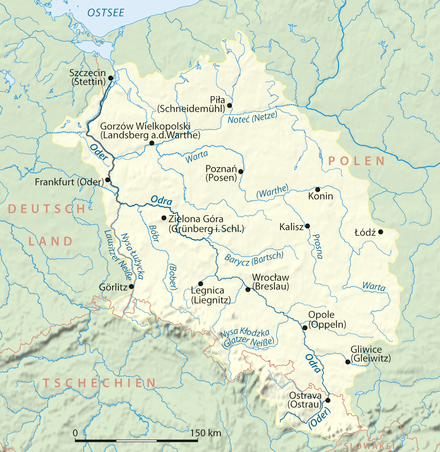Olza (river)
The ![]()
| Olza | |
|---|---|
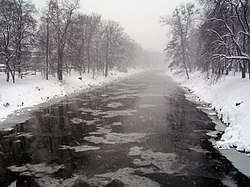 The Olza as seen from the bridge connecting Český Těšín to Cieszyn during winter | |
| Location | |
| Countries | |
| Physical characteristics | |
| Source | |
| • location | Silesian Beskids, Cieszyn Silesia |
| Mouth | |
• location | Oder |
• coordinates | 49°56′55″N 18°20′0″E |
| Length | 99 km (62 mi) (16 km or 9.9 mi in Poland, 83 km or 52 mi in the Czech Republic)[1] (some sources state 86.2 km or 53.6 mi)[2][3][4][5] |
| Basin size | 1,118 km2 (432 sq mi) (639 km2 or 247 sq mi in Czech Republic, 479 km2 or 185 sq mi in Poland)[1] |
| Discharge | |
| • average | 10 m3/s (350 cu ft/s) near estuary[1] |
| Basin features | |
| Progression | Oder→ Baltic Sea |
The river is a symbol of the Zaolzie (Polish: Trans-Olza) region, which lies on its west bank, constituting a part of the western half of Cieszyn Silesia, as depicted in the words of the unofficial anthem of this region and of local Poles, Płyniesz Olzo po dolinie (Thou flowest, Olza, down the valley), written by Jan Kubisz.
The Olza has also inspired many other artists. Among those who have written about the river are Adolf Fierla, Pola Gojawiczyńska, Emanuel Grim, Julian Przyboś, Vladislav Vančura, and Adam Wawrosz. The singer Jaromír Nohavica has used the Olza as a motif in several of his songs.
Name
The oldest surviving written mention is in a letter dating from 1290, which refers to the river Olza.[6] The river was then mentioned in a written document in 1611 as the Oldza.[7] At the end of the 19th century, with the rise of mass nationalism, both Polish and Czech activists claimed the name Olza to be not Polish enough, on the one hand, and insufficiently Czech, on the other.[8] Some Polish activists proposed the name Olsza, Czech activists Olše.
The Czech linguist and writer Vincenc Prasek demonstrated in 1900 that the name Olza has, in fact, an independent Old Slavic origin which predates both Polish and Czech.[7] This revelation has been confirmed by various etymological studies in the 20th century.[8] The regionally used form Olza is derived from the ancient Oldza. German Olsa is a re-spelling of Olza but pronounced the same. Local people always used the Olza form, regardless of their national or ethnic origin.[7]
However, the central administration in Prague saw Olza as a Polish name and when most of the river became a part of Czechoslovakia in 1920 it tried to change its name to the Czech form, Olše. However, a degree of dualism in the naming persisted until the 1960s, when the Central State Administration of Geodesy and Cartography ruled that the only official form in the Czech Republic is Olše.[7][9] Locals on both sides of the border and from both nationalities continue to refer to the river as the Olza nevertheless.
Towns and villages on the river
(from source to the mouth)
Gallery
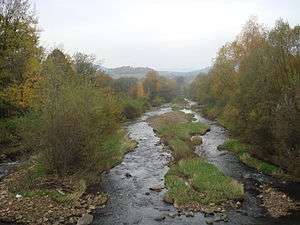 The Olza in Bukovec
The Olza in Bukovec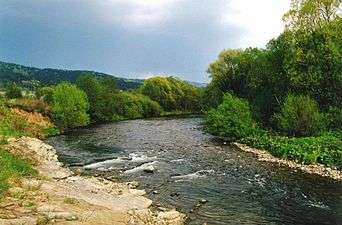 The Olza in Hrádek
The Olza in Hrádek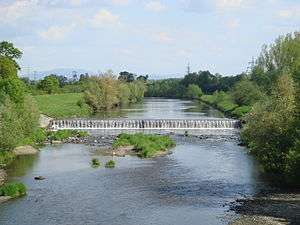 The Olza in Karviná
The Olza in Karviná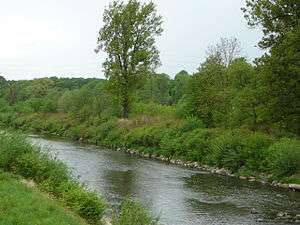 The Olza in Věřňovice
The Olza in Věřňovice
Footnotes
- Cicha et al. 2000, 18.
- 16 km or 9.9 mi in Poland, 46 km or 29 mi in the Czech Republic, 24 km or 15 mi border between Poland and the Czech Republic
- Universum. Všeobecná encyklopedie 2001, vol. 6, 624.
- Słownik geograficzno-krajoznawczy Polski 2000, 532.
- Nowa Encyklopedia Powszechna PWN 2004, vol. VI, 164.
- Mieszko, Duke of Cieszyn then wrote: ...dictorum mansorum super fluvium Olzam libere possideat...
- Cicha et al. 2000, 21.
- Gawrecki 1993, 13.
- Gawrecki 1993, 15.
References
| Wikimedia Commons has media related to Olza. |
- Cicha, Irena; Jaworski, Kazimierz; Ondraszek, Bronisław; Stalmach, Barbara; Stalmach, Jan (2000). Olza od pramene po ujście. Český Těšín: Region Silesia. ISBN 80-238-6081-X.
- Gawrecki, Dan (1993). "Olza a Olše". Těšínsko. 36 (2): 13–15.
- "Olše". Universum, Všeobecná encyklopedie. VI. Praha: Odeon. 2001. ISBN 80-207-1060-4.
- "Olza". Słownik geograficzno-krajoznawczy Polski. Warszawa: PWN. 2000. ISBN 83-01-13080-6.
- "Olza". Nowa Encyklopedia Powszechna PWN. VI. Warszawa: PWN. 2004. ISBN 83-01-14179-4.
